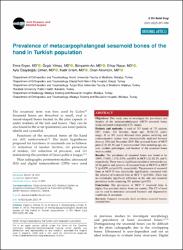| dc.contributor.author | Ergen, Emre | |
| dc.contributor.author | Yılmaz, Özgür | |
| dc.contributor.author | Arı, Bünyamin | |
| dc.contributor.author | Nacar, Erkay | |
| dc.contributor.author | Özaydoğdu Çimen, Ayla | |
| dc.contributor.author | Ertem, Kadir | |
| dc.contributor.author | Aslantürk, Okan | |
| dc.date.accessioned | 2021-08-22T10:02:29Z | |
| dc.date.available | 2021-08-22T10:02:29Z | |
| dc.date.issued | 2021 | en_US |
| dc.identifier.citation | Ergen, E., Yılmaz, Ö., Arı, B., Nacar, E., Çimen, A. Ö., Ertem, K., & Aslantürk, O. (2021). Prevalence of metacarpophalangeal sesamoid bones of the hand in Turkish population. Joint Diseases and Related Surgery, 32(2), 391-396. | en_US |
| dc.identifier.issn | 2687-4784 | en_US |
| dc.identifier.uri | https://doi.org/10.52312/jdrs.2021.79 | |
| dc.identifier.uri | 2687-4792 | |
| dc.identifier.uri | https://hdl.handle.net/20.500.12899/346 | |
| dc.description.abstract | Objectives: This study aims to investigate the prevalence and location of the metacarpophalangeal (MCP) sesamoid bones using computed tomography (CT) images. Patients and methods: A total of 767 hands of 735 patients (503 males, 232 females; mean age: 36.9±17.0 years; range, 18 to 105 years) obtained from picture archiving and communication system were retrospectively analyzed between January 2016 and December 2019. The sesamoid bones of MCP joints I, II, III, IV, and V were recorded. Data including age, sex, side, number, pathologies, and location of the sesamoid bones were recorded. Results: The prevalence of sesamoid bones was found to be 100%, 37.61%, 1.17%, 0.5%, and 80% in MCP I, II, III, IV, and V, respectively. There was no significant correlation between the sex of the patient and presence of sesamoid bone at MCP II or MCP V (p>0.970 and p=0.176, respectively). The presence of sesamoid bone at MCP II was statistically significantly correlated with the presence of sesamoid bone at MCP V (p<0.001). There was no statistically significant difference in the side and sesamoid prevalence in the remaining 703 patients (p>0.05). Conclusion: The prevalence of MCP V sesamoid bone is higher than previous studies from our country. The CT of hand can be used to determine sesamoid fractures and degenerative conditions of sesamoids. ©2021 All right reserved by the Turkish Joint Diseases Foundation | en_US |
| dc.language.iso | en | en_US |
| dc.publisher | Turkish Joint Diseases Foundation | en_US |
| dc.relation.ispartof | Joint Diseases and Related Surgery | en_US |
| dc.rights | info:eu-repo/semantics/openAccess | en_US |
| dc.subject | Computed tomography | en_US |
| dc.subject | Hand | en_US |
| dc.subject | Prevalence | en_US |
| dc.subject | Sesamoid fracture | en_US |
| dc.subject | Sesamoid bone | en_US |
| dc.title | Prevalence of Metacarpophalangeal Sesamoid Bones of the Hand in Turkish Population | en_US |
| dc.type | Article | en_US |
| dc.authorid | 0000-0001-9720-1869 | en_US |
| dc.department | MTÖ Üniversitesi, Tıp Fakültesi, Cerrahi Tıp Bilimleri Bölümü | en_US |
| dc.institutionauthor | Arı, Bünyamin | |
| dc.identifier.doi | 10.52312/jdrs.2021.79 | |
| dc.identifier.volume | 32 | en_US |
| dc.identifier.issue | 2 | en_US |
| dc.identifier.startpage | 391 | en_US |
| dc.identifier.endpage | 396 | en_US |
| dc.relation.publicationcategory | Makale - Uluslararası Hakemli Dergi - Kurum Öğretim Elemanı | en_US |
| dc.identifier.pmid | 34145816 | |
| dc.identifier.scopus | 2-s2.0-85108635311 | en_US |
| dc.identifier.scopusquality | Q2 | en_US |
| dc.identifier.wos | WOS:000661415100016 | en_US |
| dc.identifier.wosquality | Q4 | en_US |
| dc.indekslendigikaynak | Web of Science | en_US |
| dc.indekslendigikaynak | Scopus | en_US |
| dc.indekslendigikaynak | PubMed | en_US |


















